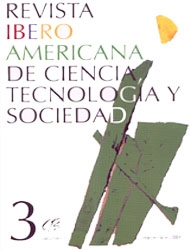Instantâneos e Paisagens sobre Biotecnologia na Imprensa Espanhola
Análise da Imprensa sobre Três Aplicações Biotecnológicas no Ano de 2002 - Alimentos e Cultivos Transgênicos, Terapia Gênica e Clonagem
DOI:
https://doi.org/10.52712/issn.1850-0013-1058Palavras-chave:
biotecnologia, divulgação científica, avaliação, opinião públicaResumo
Este artigo apresenta os resultados de uma análise quantitativa e qualitativa de conteúdo sobre as informações relacionadas à biotecnologia publicadas na mídia impressa na Espanha, a partir de uma amostra selecionada. Os resultados mostram, do ponto de vista quantitativo, que houve um volume significativo de textos jornalísticos sobre biotecnologia, dos quais, no ano de 2002, 4% chegaram a figurar na capa dos jornais. Sob uma perspectiva qualitativa, o estudo concentrou-se no rigor jornalístico dos textos. Os dados permitem concluir que apenas em um terço dos casos analisados houve verificação das informações. Quase metade dos textos (42%) manifestou-se de forma clara a favor ou contra essas tecnologias.
Downloads
Referências
ATIENZA J. y LUJÁN J. L. (1997): La imagen social de las nuevas biotecnologías en España, Colección Opiniones y Actitudes, Nº 14, Madrid, Centro de Investigaciones Sociológicas.
BAUER, M. (2001): “Science in the media as a cultural indicator: contextualizing surveys with media analysis”, en Between Understanding and Trust. The Public, Science and Technology, Amsterdam, Harwood Academic Publishers, pp. 157-179.
BAUER, M. (2002): “Controversial medical and agri-food biotechnology: a cultivation analysis”, en Public Understanding of Science, Nº 11 (abril), Sage Publications, pp. 93-111.
CASASÚS, J. M. (1998): Ideología y Análisis de los Medios de Comunicación, Barcelona, Libros de Comunicación Global.
CASINO, G. (2003): “La información en salud en los medios de información general”, en SÁINZ (dir.), Infórmate en salud: los medios de comunicación y la información sanitaria, Madrid, Eneida.
CIS (2001): Opiniones y Actitudes de los Españoles hacia la Biotecnología, Estudio Nº 2.412, Madrid, Centro de Investigaciones Sociológicas.
CHEVEIGNÉ, S. de et al. (2002): Les biotechnologies en débat, París, Balland.
COMISIÓN EUROPEA (2000): Eurobarómetro 52.1: “The Europeans and Biotechnology”.
COMISIÓN EUROPEA (2001): Eurobarómetro 55.2: “Europeans, Science and Technlology”.
COMISIÓN EUROPEA (2002): Public Perceptions of Agricultural Biotechnologies in Europe (PABE), en http://www.pabe.net.
DE SEMIR, V. (2003): “Medios de Comunicación y Cultura Científica”, en Quark, Barcelona, Rubes Ed., pp. 28-29.
DURANT, J. et al. (1998): Biotechnology in the public sphere, Londres, Science Museum.
EL PAÍS (1996). Libro de Estilo de El País, Madrid, Siruela.
ELÍAS, C. (2001): “Estudio cuantitativo de las fuentes en el periodismo español especializado en ciencia”, en Revista Latina de Comunicación Social, Nº 38, Tenerife, disponible en formato electrónico en
http://www.ull.es/publicaciones/latina/2001/latina38feb/122 elias3.htm.
GAITÁN, J. A. y Piñuel, J. L. (1998): “Técnicas de Investigación en Comunicación Social. Elaboración y registro de datos”, en Experiencias e Investigación, Nº 5, Madrid, Síntesis.
OBSERVATORIO DE LA COMUNICACIÓN CIENTÍFICA Y MÉDICA, UPF (2003): Informe Quiral 2002. Medicina, Comunicación y Sociedad, disponible en formato electrónico en http://www.quiral.org/informequiral.htm.
KRIPPENDORF, K. (1997): Metodología del análisis de contenido. Teoría y práctica, Barcelona, Paidós.
LÓPEZ, M. (1995): Cómo se fabrican las noticias. Fuentes, selección y fabricación, Barcelona, Paidós.
MARKS, L. y KALAITZANDONAKES, N. (2001): “Mass Media Communications about Agrobiotechnology”, en AgBioForum, 4 (3 & 4), disponible en formato electrónico en http://www.agbioforum.org, pp. 199-208.
MORENO CASTRO, C. (2004): Medios de comunicación e información científica, Madrid, Sistema (en prensa).
MORENO CASTRO, C., LUJÁN J. L. y MORENO L. (1996): La ingeniería genética humana en la prensa: análisis de contenido de ABC, El País, y La Vanguardia (1988-93), Documento de Trabajo del IESA Nº 96-04, disponible en formato electrónico en http://www.iesam.CSIC.es/doctrab.htm.
MUÑOZ, E. (2000): “Plantas transgénicas y sociedad: unas relaciones complejas”, en La biotecnología aplicada a la agricultura, (coordinado por la Sociedad Española de Biotecnología), Madrid, Sebito-Eumedia, pp. 239-255.
MUÑOZ, E. (2001a): Biotecnología y Sociedad: Encuentro y Desencuentros, Madrid, Cambridge University Press.
MUÑOZ, E. (2001b). “Implicaciones socio-económicas en la biotecnología: nueva política científica y nuevos contextos cognitivos”, en BERGEL, S. y DÍAZ, A. (coord.) Biotecnología y Sociedad, Buenos Aires, Ciudad Argentina, pp. 365-412.
MUÑOZ, E. (2002a): La Cultura Científica, la Percepción Pública y el Caso de la Biotecnología, Documento de Trabajo CTS 02-07, disponible en formato electrónico en http://www.iesam.csic.es/doctrab.htm.
MUÑOZ, E. (2002b): Los Medios de Comunicación y los Alimentos Modificados Genéticamente, Documento de Trabajo CTS 02-11, disponible en formato electrónico en http://www.iesam.csic.es/doctrab.htm.
PARDO, R. y CALVO, F. (2002): “Attitudes Towards Science among the European Public: a Methodological Analysis”, en Public Understanding of Science, vol. 11 Nº 2, Sage Publications, pp. 155-197.
RAMÓN, D., DORCEY, E., GIL, J. V. y SERRANO, A. (2002): “GM Food in Spanish Newspapers” en Trends in Biotechnology, Londres, Elsevier, pp. 285-286.
TODT, O. (2002): Innovación y Regulación: la Influencia de los Actores Sociales en el Cambio Tecnológico. El caso de la Ingeniería Genética Agrícola, Tesis Doctoral, Universitat de Valencia, Facultat de Filosofia i Ciencies de l’Educació.
Downloads
Publicado
Como Citar
Edição
Seção
Licença
Copyright (c) 2025 CC Attribution 4.0

Este trabalho está licenciado sob uma licença Creative Commons Attribution 4.0 International License.
Todas os números de CTS e seus artigos individuais estão sob uma licença CC-BY.
Desde 2007, a CTS proporciona acesso livre, aberto e gratuito a todos seus conteúdos, incluídos o arquivo completo da edição quadrimestral e os diversos produtos apresentados na plataforma eletrônica. Esta decisão é baseada no entendimento de que fornecer acesso livre aos materiais publicados ajuda a ter uma maior e melhor troca de conhecimentos.
Por sua vez, em se tratando da edição quadrimestral, a revista permite aos repositórios institucionais e temáticos, bem como aos sites pessoais, o autoarquivo dos artigos na versão post-print ou versão editorial, logo após da publicação da versão definitiva de cada número e sob a condição de incorporar ao autoarquivo um link direcionado à fonte original.











